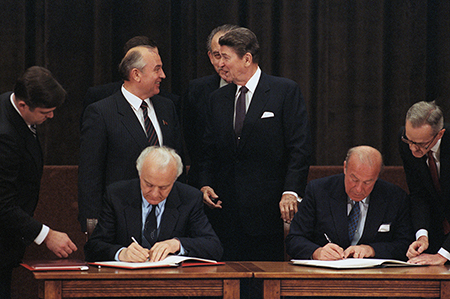"Though we have achieved progress, our work is not over. That is why I support the mission of the Arms Control Association. It is, quite simply, the most effective and important organization working in the field today."
A Model for Effective Nuclear Risk Reduction
November 2025
By Daryl G. Kimball
Well before U.S. President Donald Trump ran for the White House, he was thinking about nuclear weapons and aspired to be the person who addressed their dangers. In 1984, Trump told The Washington Post he wanted the Reagan administration to put him in charge of U.S.-Soviet nuclear arms control negotiations. “It would take an hour-and-a-half to learn everything there is to learn about missiles,” Trump said. “I think I know most of it anyway.”

Pressed by a public alarmed about the risk of nuclear war and arms racing, President Ronald Reagan’s team (minus Trump) would painstakingly negotiate an arms control approach with Soviet Leader Mikhail Gorbachev that led to agreements mandating the verifiable elimination of thousands of nuclear weapons.
In 1990, Trump told Playboy, “I’ve always thought about the issue of nuclear war; it’s a very important element in my thought process.” He called it the “ultimate catastrophe.” It certainly would be, and the risk of nuclear war and a new, unconstrained arms race is higher today than it has been since the end of the Cold War.
Unfortunately, Trump, now in his second term as president, so far has failed to achieve his long-ago vision. Rather than negotiate a lasting arms control or nonproliferation agreement, he has withdrawn from or jeopardized existing nuclear restraint agreements, adopted a more aggressive nuclear posture, and exploded the cost of the U.S. nuclear weapons modernization program. On Oct. 29, he threatened to “start testing our nuclear weapons on an equal basis.”
To his credit, however, Trump has expressed repeated interest in denuclearization talks with China and with Russia. In January, he opined: “Tremendous amounts of money are being spent on nuclear, and the destructive capability is something that we don’t even want to talk about.… So, we want to see if we can denuclearize, and I think that’s very possible.”
But Trump and his unorthodox national security team have been unable or unwilling to translate his talk into action. He still has time to do so if he and his advisers develop a coherent, pragmatic, and sustained approach for engaging Russian President Vladimir Putin, Chinese President Xi Jinping, and other leaders.
Trump is certainly no Ronald Reagan, ideologically, temperamentally, or in terms of governance style. If Trump really wants to succeed at denuclearization, he and his team might look to the first Reagan-Gorbachev summit in Geneva in 1985.
Unlike Trump’s three-hour tete-a-tete with Putin in Alaska in August, that summit lasted three days and took more than two months of preparation. Reagan and Gorbachev agreed on several key principles that established a foundation for detailed talks on nuclear arms cuts. They agreed that “a nuclear war cannot be won and must never be fought” and pledged that neither side would seek military superiority.
The two leaders also endorsed the principle of 50-percent reductions in their respective nuclear arsenals, as well as an interim agreement to phase out intermediate-range nuclear-armed missiles. Because these issues are complex and negotiations require give and take, Reagan and Gorbachev also agreed on the need for regular, intense dialogue at various levels to operationalize their top-level directions.
To make concrete progress in today’s complex geostrategic environment, Trump and Putin should formally agree to Putin’s Sept. 22 offer to continue respecting the central limits of the New Strategic Arms Reduction Treaty for at least one year after the treaty expires Feb. 5, 2026, which Trump has called “a good idea.” This would reduce tensions, forestall a costly strategic arms buildup, create leverage to curb China’s nuclear buildup, and buy time for talks on a broader, more durable, follow-on framework deal.
As Reagan and Gorbachev did, Trump and Putin should direct their teams to begin negotiations on a new, more comprehensive agreement on further offensive nuclear constraints and recognize the interrelationship between strategic offensive and defensive forces.
Trump also has a chance to broaden the disarmament effort by inviting China, France, and the United Kingdom to freeze their nuclear forces at the current number of strategic launchers, provided Russia and the United States pursue deeper nuclear cuts. Today, Russia and the United States have fewer than 800 total strategic nuclear launchers each; China has about 550; and France and the UK have a combined total of 96.
Maintaining the de facto nuclear test moratorium and establishing a mutual freeze on strategic launchers would not adversely affect any one country’s nuclear deterrence capabilities; it would provide needed predictability and a basis for bilateral talks on further nuclear restraints and reductions.
Finally, Trump could seek to solidify the joint 1985 declaration that “nuclear war cannot be won and must never be fought” by multilateralizing the forgotten 1973 U.S.-Soviet Prevention of Nuclear War Agreement so that it commits all five major nuclear-armed states to “refrain from the threat or use of force against the other Party, against the allies of the other Party and against other countries.”
The nuclear weapons challenge is one of the most vexing and dangerous. It cannot be solved in an hour or a day, but with persistent, competent, and bold leadership, it can be solved.
